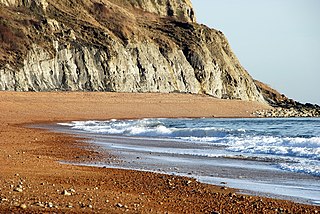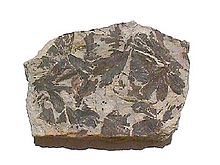Baphetes is an extinct genus of tetrapod from the Pennine Coal Measures Group and Parrot Coal, England, the Joggins Formation of Nova Scotia, and the Kladno Formation of the Czech Republic. It was first named by Richard Owen in 1854. The type species is B. planiceps.
The Whiteaves Formation is a geologic formation in British Columbia. It preserves fossils dating back to the Jurassic period.

The Lulworth Formation is a geologic formation in England. It dates from the late Tithonian to the mid Berriasian. It is a subunit of the Purbeck Group. In Dorset, it consists of three members, which are in ascending order, the Mupe Member, the Ridgway Member, and the Warbarrow Tout Member. The Mupe Member is typically 11 to 16 m thick and largely consists of marls and micrites with interbeds of calcareous mudstone. The Ridgeway Member is about 3 to 7 m thick and consists of in its western portion carbonaceous muds, marls and micrites, in the east the muds are replaced by micritic limestone. The Warbarrow Tout Member is 17 to 39 m thick and consists of limestone at the base and micrite and mudstone for the rest of the sequence, this member is the primary source of the vertebrate fossils within the formation. Elsewhere the unit is undifferentiated.

The Spilsby Sandstone is a geologic formation in England. It preserves fossils dating back to the Cretaceous period.
The Durlston Formation is a geologic formation in England. Particularly in the Isle of Purbeck. It preserves fossils dating back to the Berriasian stage of the Lower Cretaceous.
The Carstone Formation is a geologic formation in England. It preserves fossils dating back to the Albian stage of the Cretaceous period. It predominantly consists of "greenish-brown, thick-bedded, cross-bedded, oolitic ferruginous sandstone".
The Stanford Formation is a geologic formation in England. It preserves fossils dating back to the Oxfordian stage of the Middle Jurassic period, around 160 million years ago.

The Dyrham Formation is a geologic formation in England. It preserves fossils dating back to the early part of the Jurassic period (Pliensbachian).
The Fullers Earth Formation is a geological formation that outcrops in southern England. It is also mostly present in the subsurface of the Wessex Basin and offshore in the English Channel Basin, Celtic Sea Basin and St George's Channel Basin. It preserves fossils dating back to the Bathonian stage of the Middle Jurassic series. It is the lateral equivalent of the Rutland Formation and the Sharp's Hill Formation
The Kingston Formation is a geologic formation in England. It preserves fossils dating back to the Jurassic period.
The Llanfallteg Formation is a geologic formation in Wales. It preserves fossils dating back to the Ordovician period. It predominantly consists of ash containing siltstones, as wells as ash fall deposits and tuffs. It likely dates to the Darriwilian based on graptolites. The local graptolite fauna includes Didymograptus artus and Glossograptus armatus. The local trilobite fauna includes agnostids, phacopids and asaphids.
The Wittering Formation is a geologic formation in England. It preserves fossils dating back to the Paleogene period.
The Headon Formation is a geological formation found in Hampshire, England. It preserves fossils dating back to the Bartonian stage (Eocene).
The Headon Hill Formation is a geological formation found in the Isle of Wight and south Hampshire, England. It preserves fossils dating back to the Priabonian stage.

The Woolwich Formation is a geological formation in southeast England. It preserves fossils dating back to the Paleogene period.
The Downton Castle Sandstone is a geologic formation in England. It preserves fossils dating back to the Silurian period. As its name would suggest the formation predominantly consists of sandstone with minor siltstone and mudstone. The oldest known Trigonotarbid Palaeotarbus is known from the formation.

The Solent Group is a geological group in the Hampshire Basin of southern England. It preserves fossils ranging in age from Priabonian to Rupelian. The group is subdivided into three formations, the Headon Hill Formation, the Bembridge Limestone Formation and the Bouldnor Formation.
The Selborne Group is a geologic group in England. It preserves fossils dating back to the Cretaceous period. It comprises the Gault Formation and the overlying Upper Greensand Formation.

The Ballagan Formation is a geologic formation in Scotland and England. It preserves fossils dating back to the early part of the Carboniferous period (Tournaisian–Visean).
The Scarborough Formation is a geologic formation in England. It is part of the Ravenscar Group, and was deposited in the Bajocian of the Middle Jurassic







